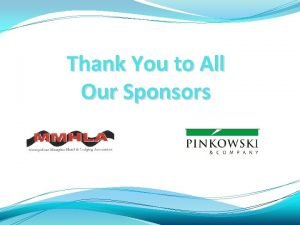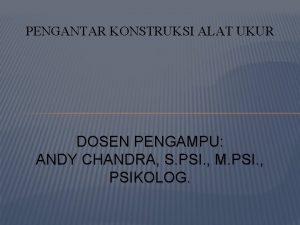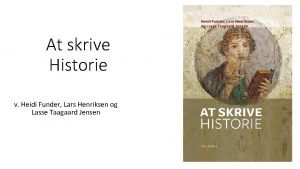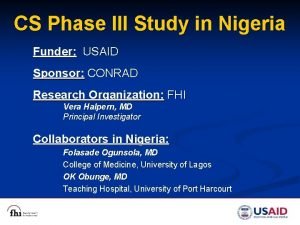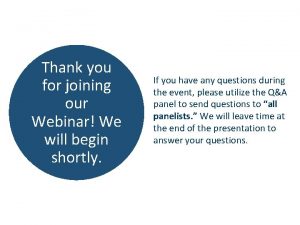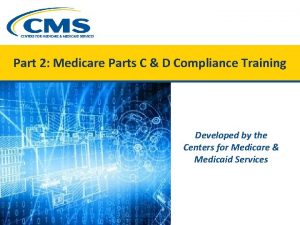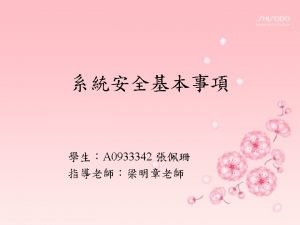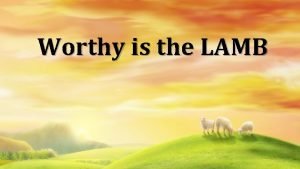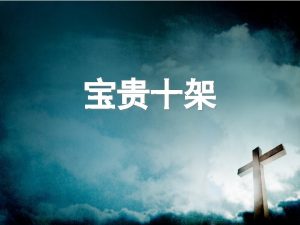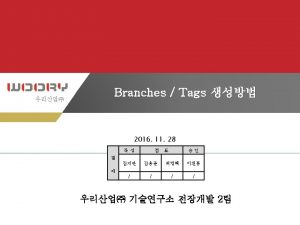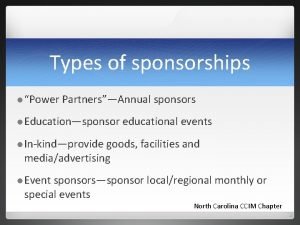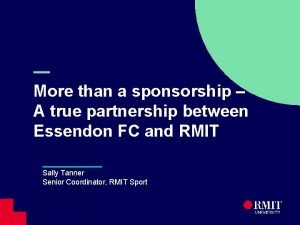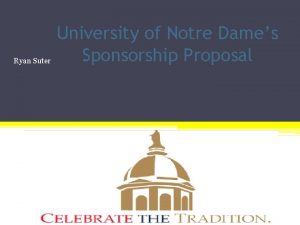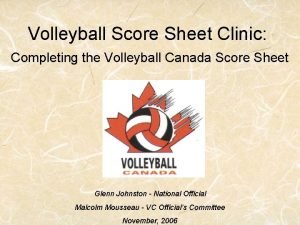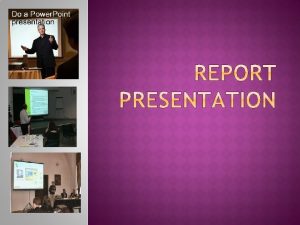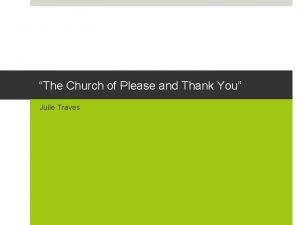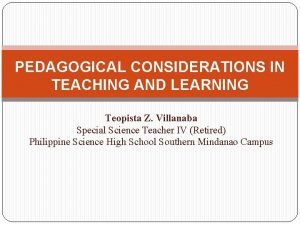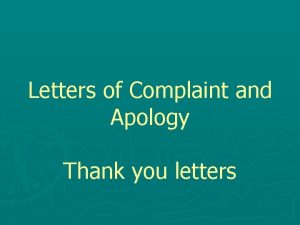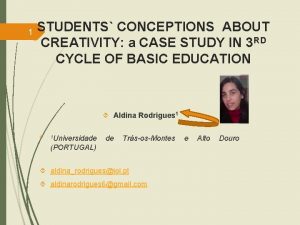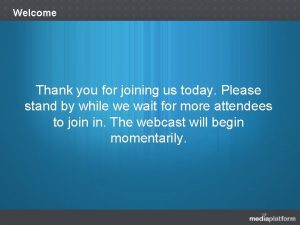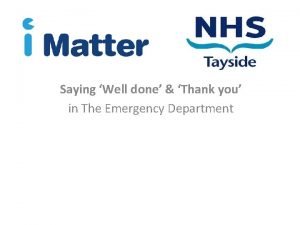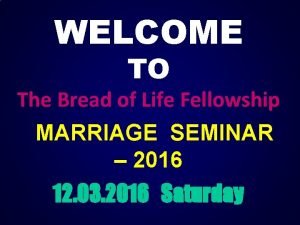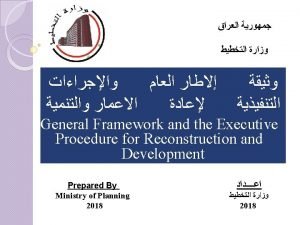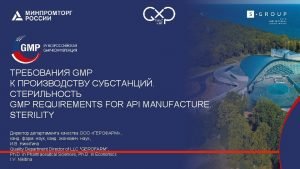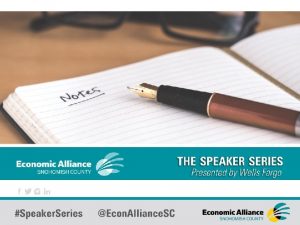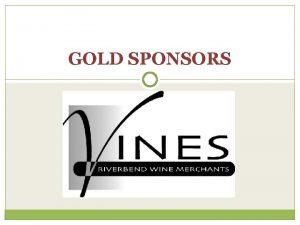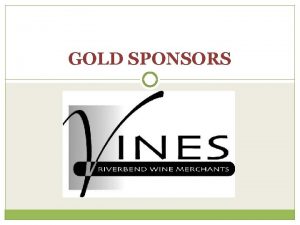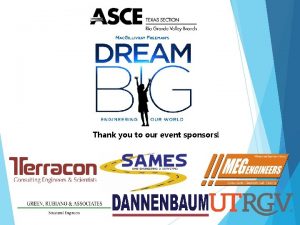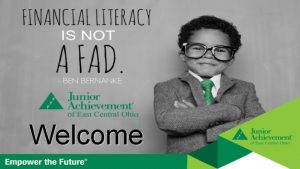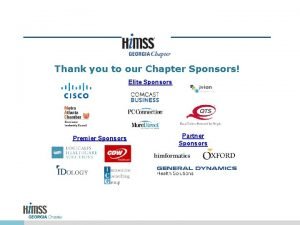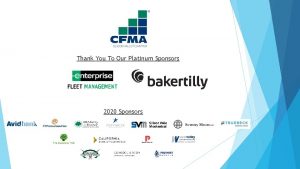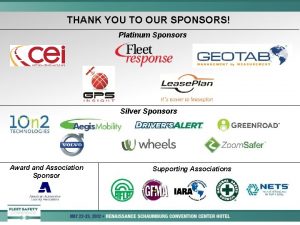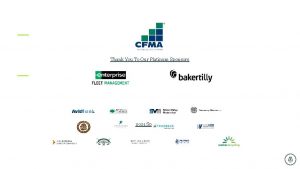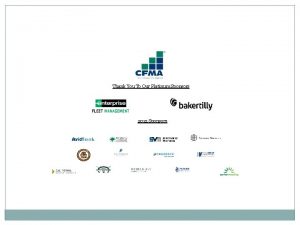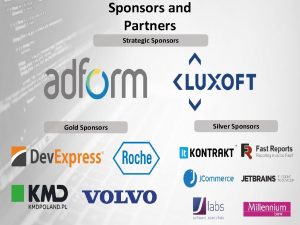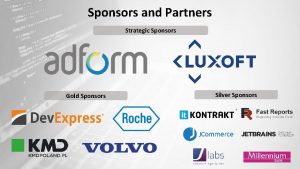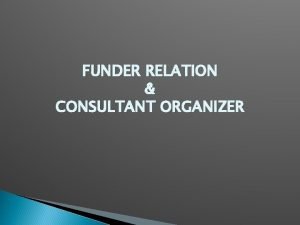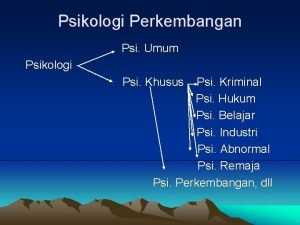Thank you to our funder and sponsors PSI










































- Slides: 42

Thank you to our funder and sponsors.

PSI National Dialogue on Fluorescent Lighting National Dialogue Meeting #3 November 6, 2008 (Day 1) © Product Stewardship Institute, Inc. November 2008 2

Recap & Status of National Dialogue (9: 15 am PST) © Product Stewardship Institute, Inc. November 2008 3

Overall Dialogue Goal: Fluorescent Lighting Promote use of energy efficient lighting while eliminating or reducing the amount of mercury and other toxins entering the environment during the lifecycle of fluorescent lamps. © Product Stewardship Institute, Inc. November 2008 4

Specific Dialogue Goals • Reduce environmental impact of manufacture of fluorescent lighting. • Increase manufacture and procurement of environmentally preferable lighting. • Maximize safe collection and recycling of spent lamps from households and businesses. • Develop nationally-coordinated system that is financially sustainable. © Product Stewardship Institute, Inc. November 2008 5

Meeting #1: Salt Lake City, Utah • • April 23 -24, 2008 Multi-stakeholder participation 24 in the room, 25 calling in Created 3 workgroups – Infrastructure (for “small”/consumer sector) – Bans & enforcement – Financing © Product Stewardship Institute, Inc. November 2008 6

Meeting #2: Seattle, Washington • • July 15 -16, 2008 37 in the room, 27 calling in Focused on financing options Continued workgroups © Product Stewardship Institute, Inc. November 2008 7

Workgroups • Infrastructure Workgroup – Focused on collection infrastructure for consumer sector – Commercial sector infrastructure exists and will grow with demand • Bans & Enforcement Workgroup – Promoting education & enforcement of existing bans – Promoting disposal bans in more states • Financing Workgroup © Product Stewardship Institute, Inc. November 2008 8

Meeting #3: Objectives • Determine next steps to promote passage of disposal bans • Determine next steps to promote enforcement of existing disposal bans • Consider criteria and elements of comprehensive state/national program for fluorescent lamp recycling • Develop greater understanding of different perspectives on financing and determine next steps • Determine next steps to develop consensus methodology for performance goals © Product Stewardship Institute, Inc. November 2008 9

Meeting #3: Objectives, cont. • Review the state-of-knowledge on lamp breakage impacts, and determine next steps to gather information or develop best management practices • Determine next steps to promote voluntary retail collection & recycling of lamps • Revisit workgroup composition & focus • Consider timing, stakeholders for Meeting #4 – Chicago, IL with funding from U. S. EPA Region 5 – Tentatively scheduled for March 3 -4, 2009 © Product Stewardship Institute, Inc. November 2008 10

Bans & Enforcement Workgroup & Discussion (9: 30 am PST) © Product Stewardship Institute, Inc. November 2008 11

Bans & Enforcement Workgroup members: • Paul Abernathy, Association for Lighting & Mercury Recyclers • Linda Barr, Shayla Powell & Wendell Tomes, U. S. Environmental Protection Agency • Becky Jayne, IL Environmental Protection Agency • Mark Kohorst, National Electrical Manufacturers Association • Alex Pashley, UT Dept. of Environmental Quality • Rob Rieck, WA Dept. of Ecology © Product Stewardship Institute, Inc. November 2008 12

Workgroup Purpose 1) Encourage compliance with, and enforcement of, existing bans or other regulations 2) Pass disposal bans in more jursidictions © Product Stewardship Institute, Inc. November 2008 13

Promoting Compliance & Enforcement Press release drafted: 1. Publicizes enforcement actions taken against businesses improperly managing lamps 2. Encourages building managers & others to comply with applicable requirements 3. Will highlight 2 -3 examples of violations/penalties – Looking at non-industrial sites with recognizable names 4. Quotes from ALMR, NEMA, PSI 5. Websites provided to find state-by-state regulations, recyclers, and drop-off locations for consumers © Product Stewardship Institute, Inc. November 2008 14

Promoting Compliance & Enforcement Strategy for release: • Targeting trade journals & associations nationally – • • Waste News, BOMA, others? States welcome to adapt for local release Timing? © Product Stewardship Institute, Inc. November 2008 15

Promoting Compliance & Enforcement • Are there other steps this group can take to promote compliance & enforcement? – At last meeting, we discussed case studies, enforcement expert presentations/calls, but these did not become priorities for the Workgroup – We will discuss public education in general later in this meeting, but is more specific compliance education needed (for example, for the commercial sector)? © Product Stewardship Institute, Inc. November 2008 16

Passing Disposal Bans in Additional States • Compiled information for those interested in creating a disposal ban for fluorescent lamps – Model disposal ban language • Draws on existing language, primarily NH (passed) and WA (draft) – Overview of mechanisms (state legislation most common) – Examples of existing disposal ban language – Examples of artwork educating about disposal bans © Product Stewardship Institute, Inc. November 2008 17

Model Disposal Ban Language • Applies to all Hg products, except FDA-approved pharmaceutical products • Either recycle or dispose of as hazardous waste • Prohibits disposal in water, wastewater treatment, or wastewater disposal systems • Minimum requirements for solid waste facilities to inform customers & prevent delivery of Hg products • Options for phased-in approach (commercial sector first, then households) © Product Stewardship Institute, Inc. November 2008 18

Passing Disposal Bans in Additional States: Next Steps • Is there information available on the success or challenges of existing bans to add to document? • Are there other next steps that this group should take to promote passage of more disposal bans? © Product Stewardship Institute, Inc. November 2008 19

Thank you to our funder and sponsors.

Comprehensive State/National Program for Lighting: Criteria & Elements (11: 00 am PST) © Product Stewardship Institute, Inc. November 2008 21

Proposed Program Criteria 1. 2. 3. 4. Promote the use of energy efficient lighting Maximize safe collection and recycling Convenient and free recycling for the consumer Levels the playing field for manufacturers, retailers, and others 5. Shares responsibility (even if not fully financially) 6. Ability to measure progress toward increased recycling 7. “Cost-effective” © Product Stewardship Institute, Inc. November 2008 22

Proposed Model Program Elements 1. Procurement o Example: Require state to purchase low mercury and most efficient lighting with recycling service component 2. Collection infrastructure for consumers o o Voluntary retail collection Convenient and comprehensive coverage (including rural) 3. Disposal ban o Commercial & consumer sectors 4. Performance metrics and goals 5. Public education 6. Financing system © Product Stewardship Institute, Inc. November 2008 23

Discussion questions on elements • Should we be thinking comprehensively (e. g. , Model) • Is legislation necessary to “level the playing field” for companies involved? • What is most useful to you? © Product Stewardship Institute, Inc. November 2008 24

© Product Stewardship Institute, Inc. November 2008

Overview of Financing Options & Discussion (1: 30 pm PST) © Product Stewardship Institute, Inc. November 2008 26

Financing Options • Focusing on consumer & possibly small commercial sectors • There is currently no consensus • Our goal today is to further the discussion of current concepts © Product Stewardship Institute, Inc. November 2008 27

Key Concepts – Any Solution • • • There is a sustainable system already in place to pay for recycling of fluorescent lamps from the commercial sector. A sustainable system is needed to pay for recycling of lamps from the consumer sector. This system should pay for collection containers, transport and recycling of CFLs and LFLs; public education; and management and reporting. Increasing the cost of the product will decrease demand should be avoided/minimized. Paying an end-of-life fee will discourage consumer recycling and should be avoided. © Product Stewardship Institute, Inc. November 2008 28

Financing Options • • • Overview of financing options (Theresa Stiner) Industry concept (Joe Howley) Industry concept – discussion Cost internalization – discussion Utility – discussion Where does this leave us? © Product Stewardship Institute, Inc. November 2008 29

General Premises from Manufacturer Perspective • National program is preferable to state-by-state • Avoid increasing cost of product (thereby discouraging purchase and use of CFLs) • Environmental benefits of using the product are greater than the environmental recycling concerns and are of an equal or higher importance when developing solutions. • Convenient recycling should be free to consumers © Product Stewardship Institute, Inc. November 2008 30

Manufacturer Concept for a National Solution • Utilities use existing mechanisms in the short-term to fund recycling programs – Offered to retailers to start voluntary recycling programs using a small part of energy efficiency funding currently used as incentives for CFL use. • Incorporate lamp recycling for consumers into cap-and -trade legislation for medium to long-term solution – Industry stewardship organization and/or U. S. EPA to manage program – Retailers implement voluntary collection programs – $ comes from sale of GHG emissions credits • Legislation could be introduced w/in next year © Product Stewardship Institute, Inc. November 2008 31

Financing Options • EPR discussion – pros/cons (Theresa Stiner slide 9) • Utility discussion – pros/cons (Theresa Stiner slide 14) © Product Stewardship Institute, Inc. November 2008 32

Financing Options • Who Pays? – Manufacturers – Utilities – Retailers? • How Much? • Short, Medium, Long-Term • Where does this leave us? © Product Stewardship Institute, Inc. November 2008 33

Thank you to our funder and sponsors.

Performance Metrics Options & Discussion (3: 15 pm PST) © Product Stewardship Institute, Inc. November 2008 35

Performance Metrics • • Establish baseline & measure progress Make changes to program if desired impact not achieved Communicate achievements externally May be required by legislation or set administratively © Product Stewardship Institute, Inc. November 2008 36

Effective performance measures should be… • • Tied closely to outcomes of public concern Based on publicly available data and defensible (and conservative) assumptions Straightforward to explain and use Other criteria? * Extensive work in this area has been done by Stratos consultants as presented at the PSI Forum in June 2008. © Product Stewardship Institute, Inc. November 2008 37

Two General Approaches Ø Collection quantities/rate Ø Robustness of program © Product Stewardship Institute, Inc. November 2008 38

Robustness of the Program Is the program easy to use and efficient? • – – % of target population aware of the program cost/unit collected customer satisfaction with program population within a certain proximity of--or average travel distance to--collection site © Product Stewardship Institute, Inc. November 2008 39

Robustness of the Program Pros • – – Those who run and use the program (and may share program goals) provide data for measurement Measurement requires fewer data, and data may be of higher quality (fewer assumptions required) Cons • – Does not directly measure the intended impact of the program (keeping lamps out of landfills/incinerators) © Product Stewardship Institute, Inc. November 2008 40

How might this work in King County? Awareness • – Population within a certain proximity/average travel distance to collection sites • – • Survey of residents Collection locations & population data Quality of service © Product Stewardship Institute, Inc. November 2008 41

How do we move forward? Establishing an agreed-upon methodology will save time and effort We know collection rate data is difficult to get Are “robustness of program” metrics acceptable alternatives, or only complementary to actual collection data? Is developing a methodology a priority for this group (should it be a next step)? • • – Which approach, or combination of approaches, should be used? © Product Stewardship Institute, Inc. November 2008 42
 Thanks to all our sponsors
Thanks to all our sponsors Andy chandra s.psi m.psi
Andy chandra s.psi m.psi Populærvidenskabelig artikel srp eksempel
Populærvidenskabelig artikel srp eksempel Heidi funder
Heidi funder Thank you for joining our webinar
Thank you for joining our webinar Medicare part c d
Medicare part c d Thank you for your listening!
Thank you for your listening! Worthy is the lamb high and lifted up
Worthy is the lamb high and lifted up Thank you lord you died for me
Thank you lord you died for me Thank you any question
Thank you any question Types of sponsors
Types of sponsors Essendon fc sponsors
Essendon fc sponsors Calgary flames sponsors
Calgary flames sponsors Jeopardy sponsors
Jeopardy sponsors Notre dame football sponsors
Notre dame football sponsors Awareness of ourselves and our environment is:
Awareness of ourselves and our environment is: Is our awareness of ourselves and our environment.
Is our awareness of ourselves and our environment. Our awareness of ourselves and our environment.
Our awareness of ourselves and our environment. Awareness of ourselves and our environment
Awareness of ourselves and our environment Welcome and thank you for joining us
Welcome and thank you for joining us Volleyball alberta score keeping
Volleyball alberta score keeping Thank you for coming here today
Thank you for coming here today Thank you julie
Thank you julie Spiral progression in science
Spiral progression in science Thank you and apology letter
Thank you and apology letter Useful phrases for emails
Useful phrases for emails The end and thank you images
The end and thank you images Ib
Ib Welcome and thank you for joining us
Welcome and thank you for joining us Well done and thank you
Well done and thank you Thank you and god bless
Thank you and god bless Thank you very much for your attention.
Thank you very much for your attention. Thank you for your attention
Thank you for your attention Thinking affects our language which then affects our
Thinking affects our language which then affects our Our census our future
Our census our future Christ be our light
Christ be our light Our life is what our thoughts make it
Our life is what our thoughts make it We bow our hearts
We bow our hearts Our census our future
Our census our future Our life is what our thoughts make it
Our life is what our thoughts make it Money madness poem line by line explanation
Money madness poem line by line explanation God our father christ our brother
God our father christ our brother Our future is in our hands quotes
Our future is in our hands quotes
